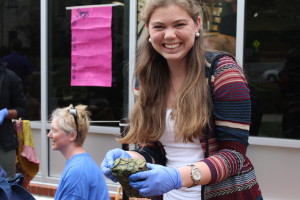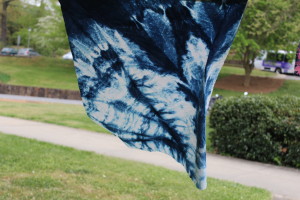
WCU student Samantha Taylor prepares her fabric for dye. Photo by Julia Hudgins
Narrowly missing the rain, students, faculty and visitors gathered together to learn how to naturally dye fabrics at the Mountain Heritage Center outside of Hunter Library on April 21.
Erin Tapley, from Western Carolina University’s School of Art and Design, ran the event, and taught each person how to dye their very own piece of cloth using natural dyes such as indigo and walnut.
The process was an easy one to learn, and it was comparable to how you would tie dye a t-shirt at home except, according to Tapley, these dyes have none of the chemicals that are normally found in store bought cloth and dyes.
Because these dyes only work on natural fabrics each person would start by choosing their own piece of natural fabric provided by Tapley and those who ran the event. Tapley stated that in the past she had attempted to dye other types of cloth, and that polyester refused to take the dye at all, whereas other fabrics such as silk took the colors exceptionally well.
After choosing their fabrics the participants would wrap it tightly around poles, or square shaped stones. Rubber bands were used to not only hold the fabric in place but also to create the designs. Tapley also demonstrated how you could use things like small rocks to help create bigger bolder designs on the fabric.
Then they would dip the fabrics into a dye created over a week ago using either walnuts, that made light brown color, or indigo, which made a deep blue.

One of the finished fabrics dyed with indigo hung outside of Hunter Library. Photo by Julia Hudgins.
Native Americans have used walnuts and other plants to dye fabrics for hundreds of years. According to the United States Forrest Service, Native Americans used black walnuts 12 different ways to dye their fabrics.
The dye, though beautiful, had a strong smell because one of the key components to these dyes is the addition of animal urine.
“The dye is alive in a way, and it feeds off the carbohydrates found in the urine and that lets the dye to do its job,” explain Tapley.
Tapley went on to say that you could purchase the powder that contained the urine at specialty stores in Asheville.
After sitting in the dye for up to five minutes the fabric is then taken out and drained thoroughly using your hands. Gloves were provided by Tapley to prevent the dyes staining the participants hands. The fabric then was quickly placed in vinegar to counteract the smell and to act as a cleaning agent. When this was done, the rubber bands were removed and everyone hung their creations up to dry on clothes lines outside of Hunter Library.
One of the most unique parts of natural dying is that as the piece of cloth dried the colors of it would slowly change. When first taken out of the dye the indigo started as a light green, however in only 15 minutes the cloth transformed itself into the signature deep blue.
Those who attended the event enjoyed the lesson and the creative process.
“It was really fun and interesting. You actually got to choose what you wanted your fabric to look like and seeing what your creation looked like afterwards was really cool,” said Samantha Taylor a WCU student.



